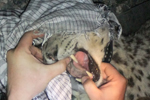Pakistan’s national mammal, the markhor, is making a remarkable comeback in the country as a result of community conservation efforts, according to the Wildlife Conservation Society (WCS).
Surveys this year in the Kargah region of Northern Pakistan’s Gilgit Baltistan territory, have estimated 300 individuals of this large wild goat, up from a low of 40-50 animals in 1991. What’s more, the surveys suggest that numbers across the whole Gilgit Baltistan territory may have boomed to 1,500 individuals, whereas in 1999, there were believed to be fewer than 1,000 left. This represents an impressive climb—even for the markhor.
“We are thrilled that markhor conservation efforts in Pakistan are paying off,” said Peter Zahler, WCS Deputy Director of Asia programs, in a press release. “Markhor are part of Pakistan’s natural heritage, and we are proud to be assisting the communities of Gilgit-Baltistan and the Government of Pakistan to safeguard this iconic species.”
Markhor are recognized for their iconic corkscrew horns, which can reach an impressive 5 feet (1.52 meters) in length. During the rut, males will use these to gain breeding rights. Markhor are highly adapted for life in the mountainous regions of the Western Himalayas and are regularly found browsing almost vertical cliff-faces. These herbivorous animals typically inhabit scrub forests made up primarily of oaks, pines, and junipers where they are able to feed on grasses, leaves, herbs, fruit and flowers. Their grizzled light brown to black coat is usually short and smooth during the warmer months before growing long and thick in the cold winter months. Markhor may live to approximately 12-13 years.
 Male markhor with kid. Photo by: Graham Jones/Columbus Zoo and Aquarium. |
Markhor are also important prey species for top carnivores like wolves and snow leopards. But markhor are subject to threats such as illegal hunting, habitat destruction and competition with domestic goats and sheep. As a result, they have been listed as Endangered by IUCN since 1994, with a 2008 global population of less than 2,500 across 5 countries: Pakistan, Afghanistan, Tajikistan, Uzbekistan and India.
The WCS have helped develop a conservation program that trains local wildlife rangers and forms community conservation committees. The rangers conduct wildlife surveys and focus on the implementation of laws and regulations relating to hunting. Their success has seen much of the illegal hunting and logging cease in the areas where they are deployed. The WCS Pakistan program now covers 4 districts with a total of 53 community conservation committees.
Markhor are also monitored and protected as they travel. A new management scheme called ‘markhor conservancy’, where markhor home ranges are used to link different village resource committees, has been developed to help safeguard the animals. The WCS also aims to help communities protect other wildlife in the region such as the snow leopard and Asiatic black bear.
Related articles
First snow leopards collared in Afghanistan as species faces rising threat from climate change

(07/18/2012) Scientists have captured and collared two snow leopards (Panthera uncia), arguably one of the world’s most elusive predators, in Afghanistan for the first time. Undertaken by researchers with Wildlife Conservation Society (WCS) and Afghani vets, the successful operation was conducted as a new study finds that snow leopard habitat could shrink by nearly one-third due to anthropogenic climate change in the Himalayas.
Small town rises up against deforestation in Pakistan
(01/02/2012) The town of Ayun, home to 16,000 people in the Chitral district of Pakistan, has been rocked by large-scale protests and mass arrests over the issue of corruption and deforestation in recent days. Villagers are protesting forest destruction in the Kalasha Valleys, the home of the indigenous Kalash people.
Photos: biologists surprised by world’s biggest leopard in Afghanistan

(12/05/2011) When biologists with the Wildlife Conservation Society (WCS) reviewed recent photos from camera traps in the Hindu Kush region of Afghanistan they were shocked to find a snarling image of the world’s largest leopard: the Persian leopard (Panthera pardus saxicolor). Listed as Endangered by the IUCN Red List, the subspecies was thought long-vanished from the Hindu Kush. Photos from the camera traps—automated cameras that use an infrared trigger to catch wildlife—also showed lynx (Lynx lynx), wild cat (Felis silvestris), Eurasian wolf (Canis lupus lupus), red fox (Vulpes vulpes), and stone marten (Martes foina).
Viable population of snow leopards still roam Afghanistan (pictures)
.150.jpg)
(07/13/2011) Decades of war and poverty has not exterminated snow leopards (Panthera uncia) in Afghanistan according to a new paper in the International Journal of Environmental Studies, written by researchers with the Wildlife Conservation Society (WCS). Instead the researchers report a healthy population of the world’s most elusive big cat in Afghanistan’s remote and peaceful Wakhan Corridor region. Monitored by camera trap in the region, WCS researchers were able to identify 30 snow leopards in 16 different locations.
Afghanistan protects 15 additional endangered species
(03/02/2010) Afghanistan’s National Environment Protection Agency (NEP) has added 15 species to its Protected Species List, totaling 48 species now under protection. The new species includes the large-billed reed warbler, which was only recently discovered in the Central Asian nation. Fortunately, by law newly discovered species in Afghanistan receive automatic legal protection.